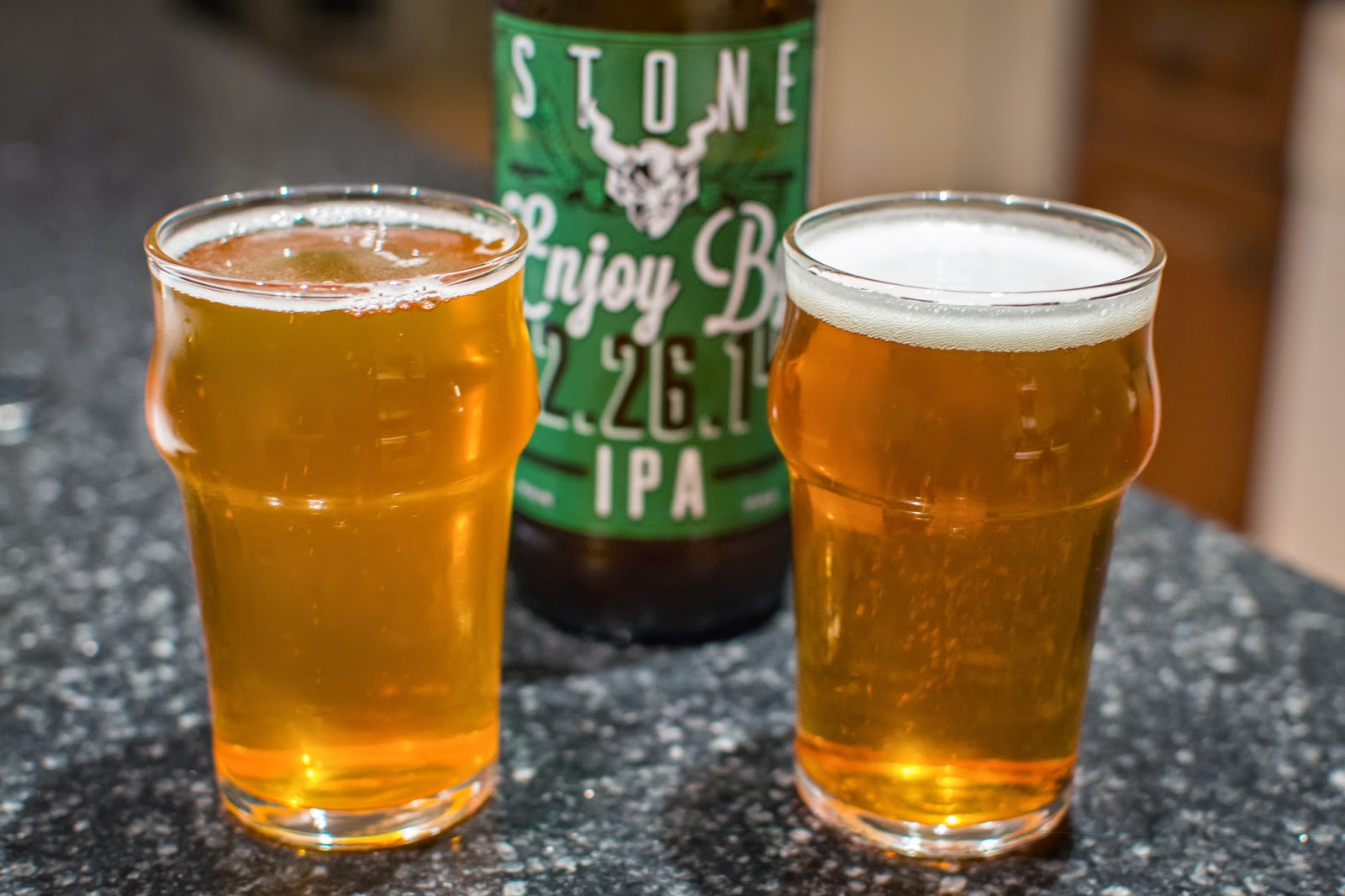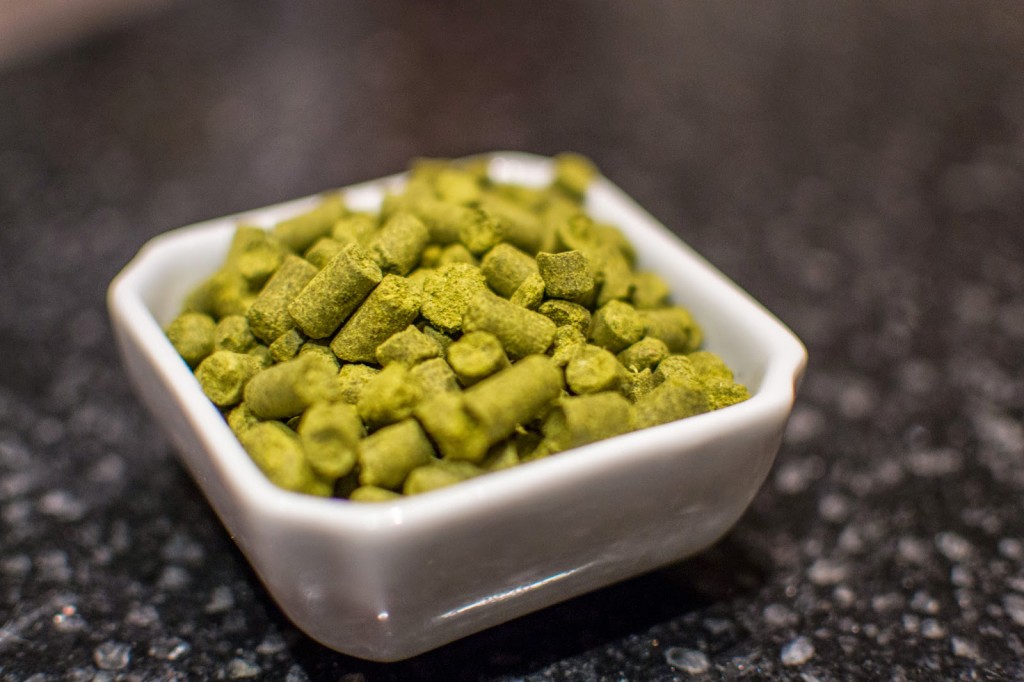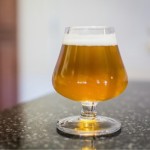Enjoy By 12.25.14 (and some dry hopping tips)

I think this is like the 4th or 5th time I’ve brewed this beer, so sorry if it’s getting a little repetitive. With the holidays fast approaching, and 1lb of last year’s Nelson Sauvin and Galaxy in the freezer I needed to use up, this recipe was kind of a no-brainer. I also find it interesting, as Stone has started to release this beer with wider distribution, I think a little of the novelty has worn off. It’s still one of the best DIPAs available these days, and one of my all-time favs. I have a theory regarding the availability of a beer and how good it’s perceived as a result, but we’ll save that topic for a later date.
We’re not really changing much as far as the recipe goes. In fact everything I did was just because I had some hops to use up. I mash hopped the beer with Pacifica because I don’t feel the mash hop really makes that much difference. I also peppered in a little El Dorado into the 15 minute addition. As for the yeast, I prepped a 3L starter of WLP090 a good 4 days prior, and crashed the starter the night before the brew.
It was a rather warm fall, which made for a really nice day to be brewing outside. I mashed this long and low for 75 minutes at 147. The mash hops made the recirculation flow a little slower than normal, but it didn’t cause any problems. After a quick sparge, this was boiled for 90 minutes, then chilled down nice and low to 58F. Fermentation started very quick for this beer, as it was slowing down within 3 days, and done after 5.
Brewed: 11-09-14
Dry Hopped: 11-13-14
Kegged: 11-21-14
OG: 1.081
FG: 1.011
ABV: 9.3%
IBU: 90
6 Gallons
8.25lbs English Pale Malt (3.5L)
8.25lbs 2-row
1lb Dextrose
Mash at 147* for 75min
2oz Pacifica – Mash Hopped
1.2oz Apollo @ 90
1oz ea. Simcoe, El Dorado, Northern Brewer, Amarillo @ 15
1.25oz ea. Citra, Cascade, Centennial @ Flameout
Whirlpool for 20min
WLP090 – Super San Diego Yeast
Dry Hop 1: 1.5oz ea Nelson Sauvin & Galaxy
Dry Hop 2: 1.5oz ea Nelson Sauvin & Galaxy
 I wanted to use this post as a bit of a springboard to talk about some dry hopping techniques. It tends to be one of the questions I get asked most about, so I wanted to address some of the more common questions.
I wanted to use this post as a bit of a springboard to talk about some dry hopping techniques. It tends to be one of the questions I get asked most about, so I wanted to address some of the more common questions.
First off, oxidation is definitely the boogeyman that it’s made out to be. I can’t stress that point enough. My IPAs improved 3-fold once I started to get really serious about purging everything with CO2.
Secondly, yeast contact is, and isn’t all that bad. I’ll explain. I used to shun the practice of dropping the dry hop dose into the primary. From my experience the hop notes were muted, and the dry hop character just wasn’t near as strong. I also found some of the pellets got stuck in the yeast cake, and never fully broke apart.
I’ve found a use for this practice though with multi-stage dry hops. Lately I’ve been adding the first dose in the primary while there is still a fair amount of yeast activity. This ensures the pellets will mix thoroughly, and any O2 in the pellets will be scavenged by the yeast. I’ll then rack to a CO2-purged keg, and dry hop the second dose there. Finally the beer is racked to a clean keg for serving. This might sound like a lot of work, but I find that it best replicates the typical commercial brewer’s use of a conical.
Many commercial brewers including Sierra Nevada and Firestone Walker advocate adding dry hops while yeast are still active. Once fermentation is complete they’ll drop the yeast and hops, then add more dry hops. Finally they’ll chill the beer before transferring to bright tanks. For me to replicate that process it’s Primary > Dry Hops > Rack to keg > Dry Hops > Rack to clean keg.
For brewers without kegging equipment or CO2 tanks, you’ll have to experiment to see if your IPAs are better with all the dry hopping done in the primary or in the secondary. For me it was the later, but that was years ago, and I also sat on my primaries longer.
Lastly, you don’t need to dry hop nearly as long as we’ve been told. I’m finding I get full dry hop flavor and aroma with just 2-4 days per addition, which is a far cry from the 7 we’re used to.
So with all that said, let’s talk about this beer.
I dry hopped this pretty quickly. The first dose went into the primary after just a few days, and I was racking this to a keg to dry hop after a week. I sat on those hops for a 4 more days before kegging this off. It was crystal clear and fully carbed by 12/7, which was roughly when I took pictures.
So as luck would have it, Stone announced they were releasing Enjoy By 12.26.14 just about a week after I brewed this batch. It’s always nice to be able to compare a cloned beer against a fresh commercial example. Stone’s was a little lighter in color, maybe 0.5SRM or so, and a bit cloudier than mine. Although haze in beer does tend to make it look lighter, so I’m curious if the SRM was actually all that off. Either way, both beers have a bright white head, even though theirs dissipates a little quicker.
As for the aroma, let me start off by saying, this Enjoy By was rather different than previous versions. It had a massive, very noticeable pineapple aroma, and that’s not ‘pretenious-beer-taster-talk’. I literally handed a glass to my wife and asked her: “What does this smell like?” to which she replied:”It smells like pineapple juice. What beer is that?”. My version smelled like what I remember Enjoy By smelling like: tropical, yet dank, with plenty of citrusy aroma. There’s just that unmistakable smell of the Nelson/Galaxy combo. The flavor of the two beers was much more similar. The pineapple flavor carried over, but it wasn’t as strong as it smelled. Both beers hid their alcohol content well, and mouthfeel was very similar for both.
All in all, This beer turned out fantastic. It’s just a really great DIPA recipe, there really isn’t much more I can say; I could drink this ’till the cows come home. I am rather curious what Stone did differently with that 12.26 batch though. It was actually a very good beer, and the pineapple aroma was something new for an IPA. I suppose we’ll figure that out another day though.
P.S. We’re on Instagram now, @bertusbrewery. Feel free to follow us, and use the hashtag #bertusbrewery if it’s relevant.
Cheers




It's interesting you mentioned 12/26 not smelling like it used to. I noticed the same thing, and just today had a glass of 2/14 and once again I noticed the lack of nelson funk. I just recently had a Lagunitas Infusion 26 and that beer straight up tasted and smelled like pineapple. Wonder what hop they're using…
In regards to the dry hopping for 2-4 days versus the 7 days. See Peter Wolfe's (AB scientist) Masters thesis – https://ir.library.oregonstate.edu/xmlui/handle/1957/34093
If you look at the sensory data, the majority of the measures are mostly there by 1 day, and the maximums are all around four days, which little benefit of going longer. Stirred hopping substantially increases sensory measures (and chemical) of hop extraction.
On the latest Beersmith podcast, Mitch Steele is on discussing latest trends with IPAs. Around the 18 minute mark he begins discussion hop substitutions. He indicates that Stone has problems procuring enough Nelson for the dry hop in Enjoy By. As a result, they've substituted some New Zealand Motueka and Australian Helga; mostly Motueka supplanting the Nelson. He indicates this has been done for nearly a year now.
I recall hearing something similar from Mitch at NHC in 2013. He basically said that they were experimenting with using a small amount of a bunch of different hops to plan for hop shortages or profile changes in the future. I was under the assumption that Enjoy By's hop bill was in constant flux? In theory small amounts of a larger number of hops should decrease the flavor changes, but clearly not.
that new stir plate from northern brewer can fit car boys on it, i'm wondering what might happen if you did all your dry hopping on a stir plate? hmm…
Scott, do you still use gelatin? If so, at what point in the process?
Quick Question, in regards to highly hopped beers such as you do alot of these, how do you go about harvesting the yeast from these batches? I assume in batches where you dryhop more than once, you'd do the first in primary, then rack to secondary for the second dryhop (firestone walker/enjoy by etc.) theres alot of talk around hops contaminating the yeast andgiving different flavour than what your looking for?
Hi Scott,
Just had the 2/14 Enjoy By. The recipe is definitely different. (At least Hop-wise) It just doesn't have the 'dank' that was there in previous years. I guess this is what happens when you ramp up production on this scale. I hope this never happens to Pliny (fingers crossed).
Brewed a batch yesterday. Made some hop substitutions and used some Stone yeast I harvested from two bottles of Ruinten. Fermentation is off to a strong start. When I hit it with the second shot of oxygen this morning, the hop aroma was simply wonderful…
Can anyone tell me whether adding 3oz hops to steep for 10 mins at flameout will lead to grassy flavours? Want to avoid going OTT with the flameout hops. Also what proportion to reduce bittering hops if I'm adding that much at flameout without chilling right away? Thanks
Chris, 3 oz of hops at flame out is nothing. My favorite IPA recipe so far was 6oz at 5 minutes, 6oz at flame out (30 minute steep/hop stand), and 6oz dry hop. I think grassy is usually from an extended dry hop 14+ days. I've used too many types of hops at once and got a muddled generic hop flavor, but still not grassy.
Hope that helps!
–Chris
Why the 75 minute mash and why the 90 minute boil?
Hey Scott I have some Weyermann Vienna I need to use up and was thinking about using it 50/50 with Simpson's Maris Otter plus the dextrose in the grain bill. Your thoughts? I haven't brewed much with the Vienna and was also thinking of using it in a SMASH to see what it brings to the table versus Munich.
Hi Scott – thanks for continually updating this site – it's the best source of beer advice/recipes I've seen anywhere! I have a question related to one of your posts on IPAs from a while back. If you were going to steep hops after flameout for 10 minutes, what percentage would you reduce bittering hops by to account for the additional bitterness?
Love this beer brewed this twice in s row. You think you could clone sculpin by ballast point ?
Scott,
I'm interested in your dry hopping process, as I've had a few hoppy beers fade quickly due to what I think is oxidized hops. I am wondering what you do to prevent hops from leaving the dry hopping leg and entering the serving keg. Cut dip tube? Filter? Thanks.
This comment has been removed by the author.
Just posted a Grain to Glass Brewing this recipe if anybody is interested hear is the link https://www.youtube.com/watch?v=tdcs8prvv_U
Cheers Brad
How violent is the fermentation for this beer? I'd love to brew it but my wife won't thank me if it makes a mess in our living room/kitchen! Do you need to worry about that sort of thing if a beer is 9% or under? Thanks!
Hi Scott are you cold crashing and if so at what point during your dry hopping process?
I don't cold crash every beer, but for beers I dry hop, I do. I cold crash just before I move the beer into the final keg. The thought is to drop as much hop material and whatever else out of suspension before racking to the final serving keg.
Do you think fining with gelatin strips away any hop aroma/flavor? If so do you add more hops to account for this loss? Is this dry hopping schedule already adjusted for such losses?
I don’t feel that it strips anything away that I like. The dry hop schedule is not adjusted for the loses. It’s simply 1lb per barrel each of Nelson Sauvin and Galaxy.
Hey Scott,
When you transfer from secondary keg into final keg…do you do it under pressure (bev out to bev out forced by CO2) or do you just rack it? Interested in trying this to minimize oxidation as you stated.
Similarly – to dry hop on the keg, you must purge the keg just by burping out the o2 ?? I can’t think of a way to dry hop in the keg AND push a keg full of sanitizer out to ensure its full of